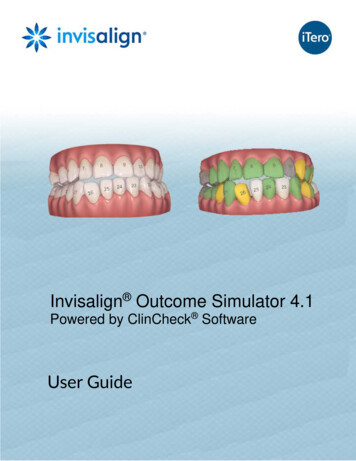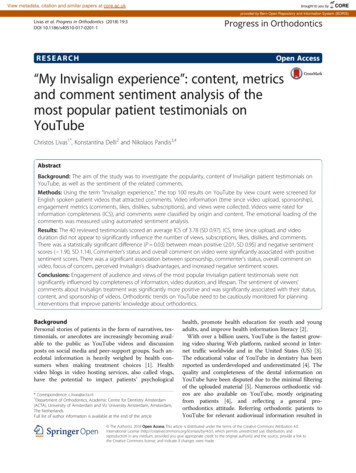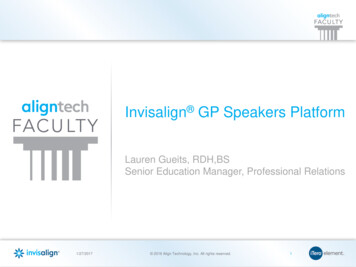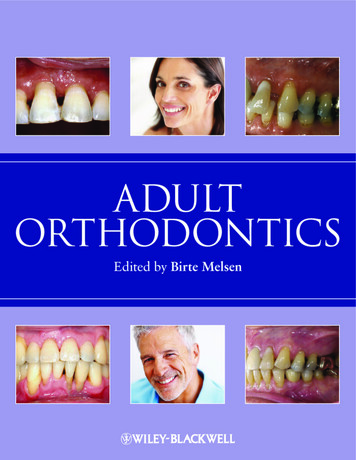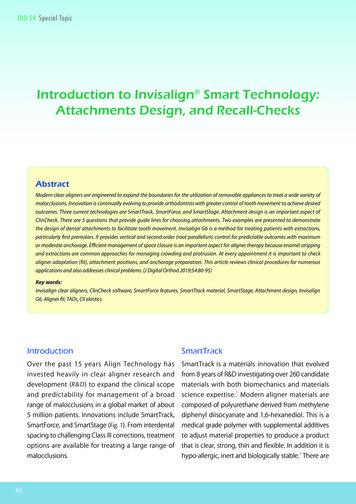
Transcription
JDO 54 Special TopicIntroduction to Invisalign Smart Technology:Attachments Design, and Recall-ChecksAbstractModern clear aligners are engineered to expand the boundaries for the utilization of removable appliances to treat a wide variety ofmalocclusions. Innovation is continually evolving to provide orthodontists with greater control of tooth movement to achieve desiredoutcomes. Three current technologies are SmartTrack, SmartForce, and SmartStage. Attachment design is an important aspect ofClinCheck. There are 5 questions that provide guide lines for choosing attachments. Two examples are presented to demonstratethe design of dental attachments to facilitate tooth movement. Invisalign G6 is a method for treating patients with extractions,particularly first premolars. It provides vertical and second order (root parallelism) control for predictable outcomes with maximumor moderate anchorage. Efficient management of space closure is an important aspect for aligner therapy because enamel strippingand extractions are common approaches for managing crowding and protrusion. At every appointment it is important to checkaligner adaptation (fit), attachment positions, and anchorage preparation. This article reviews clinical procedures for numerousapplications and also addresses clinical problems. (J Digital Orthod 2019;54:80-95)Key words:Invisalign clear aligners, ClinCheck software, SmartForce features, SmartTrack material, SmartStage, Attachment design, InvisalignG6, Aligner fit, TADs, CII elastics80IntroductionSmartTrackOver the past 15 years Align Technology hasSmartTrack is a materials innovation that evolvedinvested heavily in clear aligner research andfrom 8 years of R&D investigating over 260 candidatedevelopment ( R&D ) to expand the clinical scopematerials with both biomechanics and materialsand predictability for management of a broadscience expertise. 1 Modern aligner materials arerange of malocclusions in a global market of aboutcomposed of polyurethane derived from methylene5 million patients. Innovations include SmartTrack,diphenyl diisocyanate and 1,6-hexanediol. This is aSmartForce, and SmartStage (Fig. 1). From interdentalmedical grade polymer with supplemental additivesspacing to challenging Class III corrections, treatmentto adjust material properties to produce a productoptions are available for treating a large range ofthat is clear, strong, thin and flexible. In addition it ismalocclusions.hypo-allergic, inert and biologically stable.2 There are
SmartTrack, Invisalign JDO 54Dr. Ming-Jen Chang,Lecturer, Beethoven Orthodontic Course, TaiwanEditor, Journal of Digital Orthodontics (Upper left)Dr. Chun Hung Chen,Lecturer, Journal of Digital Orthodontics (Upper middle)Dr. Chien-Yu Chang,Lecturer, Journal of Digital Orthodontics (Upper right)Dr. Joshua, Shih-Yung Lin,Lecturer, Beethoven Orthodontic Course, TaiwanEditor, Journal of Digital Orthodontics (Lower left)Dr. Chris H. Chang,Founder, Beethoven Orthodontic CenterPublisher, Journal of Digital Orthodontics (Lower middle)Dr. W. Eugene Roberts,Editor-in-chief, Journal of Digital Orthodontics (Lower right)three different varieties: 1. LD30 (0.75mm) for Invisalign aligners, 2. EX40 (1.02mm) for Vivera and Invisalign retainers, and 3. EX15 ( 0.75mm) for Invisalign templates.SmartTrack Features1) Improved ControlAlign Technology reports proprietary data from a pilot study of 1015 patients at 5 months follow-up.Compared to the original aligner material, SmartTrack delivers optimal loads over the two-week period ofaligner wear designed to improve tracking and control of tooth movement. No data are presented but thecompany claims the results were highly significant (p 0.001) at a 99.9% confidence level (Fig. 2).1 Fig. 1: The 3 innovations of Align Technology.SmartTrack: Aligner material to supply gentle and content force.SmartForce: Precise 3D control of tooth movement.SmartStage: Optimizes the progression of tooth movement.81
JDO 54 Special Topiccurves, based on vitro measurements in a simulatedoral environment, appear to be consistent with theconclusions, but “Material Stress Relaxation” is unclearbecause stress is typically measured in Pascals notForce. A more complete report or literature referenceto the actual data for Fig. 3 would be helpful. Fig. 2:The percentage of patients remaining on track with Invisaligntreatment was significantly higher at a 5-month reviewappointment (p 0.001). See text for details.2) Improved Constant and Gentle ForceThe applied force for the original aligner materialdecayed rapidly over the first few days of wear, butdecreased at a much slower rate for the last 1012d of the two-week period. In comparison theSmartTrack material delivered a lower initial load,that decayed rapidly for the first couple of days andthen delivered a relatively constant load for the next12d (Fig. 3).3 It is concluded that SmartTrack produces3) Higher ElasticitySmartTrack aligners are composed of a more pliablematerial (Fig. 3) that is more easily stretched over adental arch, and less likely to crack (Fig. 4). The alignerthen returns more completely to its programmedshape (memory). The decreased permanent distortionillustrated helps facilitate precise tooth movement(Fig. 5). Reportedly the SmartTrack material is morecomfortable to wear than previous aligners madewith the EX30 material.34) More Precise Aligner Fita more constant and gentle load over the entire twoThe comparative fit (adaptation) of the more flexibleweek period. Furthermore, there is a significantlymaterial is tested with relatively opaque blue gel,lower initial insertion load for each new aligner,that is added to the aligner before it is fitted onwhich improves patient comfort. The comparativethe arch. The overall less intense blue color ofSmartTrack indicates it conforms more closely to thedental anatomy. Improved adaptation (Fig. 6) and the 82Fig. 3:Invisalign SmartTrack has a more constant and gentle force toachieve tooth movement. The standard aligner material requires ahigh insertion force and the load quickly decays over the two weekaligner wear period. See text for details. Fig. 4:The more elastic material is much less likely to crack when stretchedover a patients' teeth.
SmartTrack, Invisalign JDO 54SmartForceSmartForce was proposed for extrusion of teethin 2009. Later a beveled surface was added on theocclusal surface of the attachment to enhance thedelivery of extrusive force ( Fig. 7 ).4 When a load istransferred to the gingival surface of the attachment,the bevel allows the tooth to move occlusally( extrude ). Similar force vectors were developedfor attachments designed for rotational control, Fig. 5:When deformed, the highly elastic SmartTrack returns more closelyto the programmed aligner shape. See text for details.tendency for less permanent distortion (Fig. 5) areexpected to translate into improved control of toothmovement, particularly for finishing.4 Fig. 6:Aligners are filled with blue gel and seated on a typodont. Whiteareas indicate direct aligner contact, and blue areas indicate agap between the aligner and the teeth. SmartTrack demonstratessuperior adaptation (fit), particularly in interproximal andattachment areas. Fig. 7:Invisalign proposed the concept of SmartForce in 2009. A gingivalrectangular beveled attachment was designed to extrude the toothefficiently.5) Enhanced Patient ComfortSmartTrack aligners are reportedly more comfortableto wear and easier to take in and out, which isan important feature if bonded attachments arepresent. 5 Despite the improved performance,the current aligners have good clarity, estheticsand transparency, so they are an almost invisibleremovable appliance.6 In addition, SmartTrack hasresulted in improved control of tooth movement, byapplying a more gentle and relatively constant force( Fig. 3 ). These characteristics reportedly decreasetreatment time up to 50%, and tooth movementis 75% more predictable7 because of the improvedconformity to the arch (Fig. 6) and less distortion (Fig. 5).83
JDO 54 Special Topicapplication of torque ( 3 rd order correction ), andintrusion. The G4-G7 concepts were developed later.SmartForce FeaturesTo understand SmartForce capabilities, it is importantto carefully consider the attachment concept.Depending on the design of the attachment relativeto the seating (full engagement) of an aligner, force Fig. 8:An attachment on an aligner is analogous to a handle on awardrobe or cabinet. The attachment (handle) provides retentionfor an aligner. Fig. 9:Three types of conventional attachments are shown. The ellipsoidis seldom used now because of poor retention. The rectangularattachment is effective for additional retention and can be usedto apply a couple (moment) to the teeth. The beveled attachmentis still a good choice for extrusion although the newer optimizedattachments are now more common.and couples to generate moments can be appliedto move teeth. In mechanics, a couple is two parallelforces that are equal in magnitude, opposite indirection (sense), and do not share a common line ofaction. When the treatment plan calls for anythingother than tipping a tooth, an attachment( s ) arenecessary. It is essential to carefully evaluate thecouple generated by a loaded attachment, relativeto the force applied. The moment to force ratio (M:F)is directly related to the type of tooth movement:tipping (low), translation (medium) and root torque(high). Another important consideration is the equaland opposite effect of the force system on theanchorage unit. Bodily tooth movement (translation)and particularly root torque tax anchorage far morethan tipping movements.Fundamentally, a surface attachment is muchlike a handle to move a sliding door (Fig. 8 ). Priorto SmartForce, the principal attachments wereellipsoid, rectangular, and rectangular beveled( Fig. 9 ). Except for the latter, an aligner passivelyfitting an attachment only provides retention. Thebeveled attachments are worthwhile for aligningthe dentition to achieve limited orthodonticcorrection, but they are not compatible with thecomplex movement required for comprehensive84orthodontics. The G3 concept 5 for attachmentmediated tooth movement was aimed at morecomprehensive applications such as rotations andtorque control.5,7 The principal difference for G3 waspower ridges6 built into the aligner, and a directionoriented active surface on optimized attachments(Fig. 10).7 With the improved elasticity of SmartTrack(Fig. 3) a force applied to an active surface can beused to effectively move a tooth in any direction.However, anchorage must be carefully consideredparticularly if the goal to move teeth bodily (translate).There is a tendency to tip teeth with an activesurface unless there is an adequate moment forbodily movement. If it is desirable to retract a tooth,
SmartTrack, Invisalign JDO 54 Fig. 10:SmartForce is effective in two ways: 1. Built into the aligner, such as power ridges designed to control torque. 2. Active surface on an optimizedattachment to control tooth movement precisely.such as a lower third molar, the active surface willface mesially (Figs. 11, 12). The force developed tobodily move any tooth must be carefully balancedwith an appropriate moment or the tooth will tip.The type of tooth movement depends on the M:Fassociated with the applied load.There are many applications for SmartForce,depending on the design of the mechanics. The five Fig. 11 :In this stage, retraction (“distalization”) of LR8 (#17) is planned. Theshape of the #17 attachment on the aligner is a little different fromthe one on the template. This configuration produces a force thatpushes on the attachment of #17. Fig. 12:The active surface on an optimized attachment produces a couplethat is designed as an anti-tip moment during space closure.basic movements for a tooth are rotation, extrusion,intrusion, torque control of the crown, and rootcontrol. If multiple types of movement are desired,there is a hierarchy for applicable attachments thatis based on the Invisalign data base. Every optimizedattachment comes with a set of rules based on thelongterm experience of the manufacturer. Doctorscan assess treatment progress, but changingoptimized attachments is not an option. However,during a refinement (reboot) procedure, optimizedattachments can be replaced with conventionalones if desired.885
JDO 54 Special TopicSmartStageIn 2015, Invisalign released G6 along with SmartStageto improve aligner performance for first premolarextraction treatment.9 SmartStage is engineered tooptimize tooth movement progression, but it is anabstract concept in mechanics that is challengingfor many clinicians. The first application is to modifythe shape of an aligner, and the other is to adjustthe sequence of tooth movement. CombiningSmartForce with SmartStage can enhance thepredictability of clinical outcomes. A carefulapplication of the method controls unwantedtipping and anterior extrusion of incisors duringretraction.10SmartStage Features1) Optimaized Aligner ShapeDistal incisor tipping ( anterior torque loss ) andbuccal segment mesial tipping ( posterior torqueloss ) are common side effects when closing firstpremolar extraction spaces.11 With fixed appliances,clinicians can reduce these side effects with archwireadjustments such as a curve of Spee adjustment,gable bends or selecting a full-size rectangulararchwire.12 Clear aligners can simulate these effectsif they are designed to change form or modify inshape. These aligner activations work together withoptimized attachments to effectively close extractionspace. These mechanics require precise engineeringto control both the moment to force ratio on eachsegment, and the equilibrium of the entire forcesystem (Fig. 13).86 Fig. 13:Aligner activation (Smar tStage) compliments optimizedattachments (SmartForce) to eliminate undesirable tippingextrusion during retraction. Magenta curved arrows are tippingmoments when closing first premolar space. Red curved arrows arecounter moments resulting from the aligner applying active forceon optimized attachments. Dark blue curved and straight arrowsshow the direction of root control in addition to preventing anteriorextrusion.
SmartTrack, Invisalign JDO 542) Optimized Tooth Movement SequenceSmartStage technology is designed to optimizealigner shape and tooth movement progress toachieve more predictable clinical outcomes. Topreserve posterior anchorage, a two-step anteriorretraction method is proposed instead of enmass space closure;13 however, this tends to be anunattractive approach because it opens maxillaryanterior spaces. Aligners can utilize this approachwithout an appreciable esthetic deficit becausealigner material fills the space during the retractionprocess. Canines are retracted about 1/3 of theextraction space and then all six anteriors areretracted later, utilizing posterior arch anchorage(Fig. 14).9 SmartStage adapted this modified two-stepanterior retraction process, although not all cliniciansaccept this approach as effective and efficient.14,15Mini-screw anchorage for en-mass retraction withaligners is another option.Attachments DesignAre attachments necessary to move teethwith aligners?Aligners can accomplish many types of toothmovement without attachments because loads areapplied to the teeth by the surrounding material.Tipping the crowns of teeth and incisor rotationrarely require any attachments. Complex toothmovement and rotation of most teeth is difficult toaccomplish without attachments. Attempting tocorrect major malocclusions without attachments is Fig. 14:SmartStage can be programmed to optimize tooth movementsequence. Invisalign G6 is designed to retract canines first for about1/3 of the predicted space closure movement. The six-anteriors arethen retracted. This approach increases treatment time but mayhelp preserve posterior anchorage. See text for details.87
JDO 54 Special Topiclikely to be frustrating for both the patient and theforces, but applying a significant moment to theclinician. Attachment design is an important aspectcrown of a tooth requires a couple, which dependsof diagnosis and treatment planning.on the active surface of an attachment. Optimizedor vertical attachments can translate teeth byTooth movement requiring attachments?1) RotationPremolars have a small contact surface and relativelyround shape, so they usually require attachments forrotation (Fig. 15).2) ExtrusionAligners use other teeth as anchorage to developextrusive force, but the mechanics are ineffectiveincreasing the moment to force ratio (M:F) of theapplied load. For pure translation, the M:F mustapproximate the equivalent force system, meaningthe moment must be adequate to simulate a forcepassing through the center of resistance of theroot. An inadequate moment results in tipping ofa tooth while an excessive moment produces rootmovement without changing the relative position ofthe tooth.unless the aligner has a firm attachment to the4) Mesial Tooth Movementsurface of the crown to be extruded. It is very difficultAnterior translation of posterior teeth such as aif not impossible to effectively extrude most teethwithout attachments.3) TranslationBodily movement (translation) requires a relativelyhigh moment to force ratio and substantialanchorage. Aligners are effective for deliveringsecond molar is very difficult because the crownheight is limited. Thus attachments are not effectivefor generating a large moment. With aligners themesial force on the molar must be relatively low toavoid overcoming the limited moment generatedby the attachment to prevent tipping the molaranteriorly. When substantial movement of molars isrequired, aligners may not be the optimal approach.Fixed appliance are much more effective in achievingsubstantial mesial translation of molars.165) IntrusionWhen intrusion is prescribed, attachments areu n n e ce s s a ry b e ca u s e t h e a l i g n e r ca n ea silydevelop intrusive force. However, there may bean undesirable extrusion of anchorage teeth.Like translation of a tooth, intrusion can easily 88Fig. 15:Attachments are required for tooth rotation, extrusion, translation,protraction (“mesialization”), and intrusion.compromise anchorage because it is much easier toextrude a tooth than to intrude it. Attachments are
SmartTrack, Invisalign JDO 54usually required, for stabilization of anchorage teethextrusion. Attachments are not required for incisorsinto segments, to resist extrusion.intrusion ( Fig. 16 ), but the premolars serving asanchorage, do require them (Fig. 17). The attachments5 Questions for Attachments DesignClinicians are often confused by attachments.There are 5 questions to help define and designappropriate auxiliaries.can be conventional (for retention) or optimized (forextrusion and retention).Molar-Intrusion AttachmentsThe intruded molars do not need any attachments1. W h a t i s t h e p l a n n e d d i r e c t i o n o f t o o t hmovement? Mesial, distal, extrusion or intrusion?2. What is the function of the attachment?because the occlusal surfaces are adequate fordelivering the axial load. However, the adjacentpremolars do need attachments to resist theAnchorage or delivering an active load?3. Which is the active surface of an attachment? Thiscalculation is critical for estimating the amount offorce and the couple generated by programmedrecoil of the aligner. The M:F, plane of forcesystem, and underlying root structure dictate thepath of tooth movement. Like archwires, alignerstie the arch together which is helpful for keepingtooth movement under control as the active Fig. 16:The blue circle indicate there is adequate surface area on each toothfor the aligner to apply the intrusive forces. Fig. 17:Attachments designed for managing deep-bite. The solid broadarrow indicates intrusive force. The dotted arrow is the resulting(counter) extrusive force.surface of attachments move individual teeth.4. Is it feasible for an active load from an alignerto produce the desired tooth movement? Forinstance, severely crowded teeth may requireextraction, arch expansion and/or enamelstripping to avoid undesirable lip protrusion.5. Is the active force parallel to the direction oftooth movement? If so, surface attachments area wise choice.Deep-bite AttachmentsThe solutions for a deep-bite are upper incisorintrusion, lower incisor intrusion, or buccal segment89
JDO 54 Special Topicresulting extrusive loads (Fig. 18). Again, attachmentson the premolars can be conventional for retention,or optimized for extrusion and retention. Fig. 18:Attachments are designed for molar intrusion (solid broad arrows)and dotted arrows show the counter extrusive forces. Fig. 19:These 3 key points allow us to monitor our treatment resulteffectively at every appointment. Fig. 20: Teeth are not fitting into the aligner (off-tracking).3 Key Points for Invisalign G6 Recall-CheckThe Invisalign G6 is well designed to support firstpremolar extraction cases. It combines the threeinnovations of Smart Technology, to provide morepredictable and efficient root alignment. Themechanics depend on carefully monitoring threekey points: 1. aligner adaptation (fit), 2. attachmentpositions, and 3. anchorage preparation (Fig. 19).Aligner Adaptation (Fit)Teeth not fitting well into an aligner is deemedoff-tracking, which is the most common problemwith Invisalign aligners (Fig. 20). The first sign of offtracking is a gap between the aligner and the incisaledges or cusps of the teeth. This may occur for tworeasons. The first is extrusion of anterior teeth wasprogrammed into the aligner, or a canine is movingdistally. Initially there will be a small space betweenthe incisal edge or cusp of the tooth and the aligner.90This is normal when the aligners are changed, butit should not be allowed to increase as an aligneris worn. For example, the patient (Fig. 21) should beadvised to bite on aligner “chewies” especially in theoff-tracked area. The second reason for off trackingmay be that aligners are changed too frequently,before the teeth have moved to the plannedposition for the next stage of treatment. The patient
SmartTrack, Invisalign JDO 54may be trying to speed up treatment by changingAttachment Positionaligners at 7-day intervals or less. The most commonG6 SmartForce features an Optimized Retractioncorrection is for the patient to wear the problemaligner 3-5 days longer to determine if adaptation isself-correcting (Fig. 22).Attachment that is designed to work withSmartStage technology to achieve effective bodilymovement during canine retraction. The multitooth unit and staging of the G6 system is a complexsystem that is not adjustable. It is an all or noneoption (Figs. 23 and 24). Fig. 23: The G6 features and biomechanics for space closure. Fig. 24:In the Invisalign treatment sheet, the blue horizontal bar meansthe multi-tooth unit that belongs to the same group and should bemaintained. The red notation indicates tooth movement desiredwith aligner treatment.Fig. 21:Patient was advised to bite on the “chewies” to seat the aligner intoan appropriate position for better adaptation.Fig. 22: Aligner adaptation problems and the relative solutions.91
JDO 54 Special Topic Fig. 25: Illustrations are shown for maximum anchorage and moderate anchorage in the G6 system.The doctor's responsibility is to carefully check everysupplemented with Class II elastics or temporaryattachment at each appointment. Any missinganchorage devices (TADs) (Fig. 26).attachment must be replaced quickly with thetemplate supplied. A full compliment of attachmentsis critical for space closure mechanics, so the patientIntegrating Aligners and Fixed Appliancesis also asked to check the tooth surfaces with a fingerAchieving precise tooth movement to resolveevery time they take out the aligner. If an attachmentmalocclusion is the primary goal for orthodontics.is lost, an appointment with the doctor is requiredAligner therapy is popular with patients, who dowithin 7 days to repair the problem.not want to wear braces, but success with theseremovable appliance is dependent on both theAnchorage PreparationThe G6 system can be programmed with SmartStagetechnology to provide maximum anchorage. Molarstability is programmed to hold the A-P positionfor achieving maximum retraction of the anteriorsegment. Moderate posterior anchorage permits 5mm of molar mesial movement (Fig. 25 ). Theseanchorage options are programmed with theClinCheck system and must be carefully examined bythe doctor prior to approval. In order to accomplishan ideal result, anchorage preparation can be92 Fig. 26:The intermaxillary elastics and TADs can be used as anchorage for abetter treatment outcome.
SmartTrack, Invisalign JDO 54doctor and patient following instructions precisely.intelligence ( AI ), a type of technology based onThe principles for applied mechanics and anchoragemassive data bases that is increasingly prevalentare the same for all tooth movement, but the clinicalin dentistry. Utilizing vast resources, Invisalign hascourse for each approach is distinct. Both archwiresdeveloped 3 innovative technologies to expand theand aligners are indeterminate mechanics17soperiodontal ligament stress throughout the arch isscope of aligner therapy and make patients morecomfortable during treatment.unknown so the precise response to applied loadsare variable. The same risks apply to aligners andAt the initial consult, patients should be encouragedarchwires: uncertain course of tooth movement,to share their chief complaint(s) so the doctor canrelatively long treatment times, and root resorption.properly diagnose the malocclusion, relative to thepatient's needs, and decide on a general treatmentThe Insignia technology for fixed applianceplan. If a fixed appliance is selected, the mechanicstreatment was the first patent in orthodontics forare described in a straight-forward manner. On thecomputer-aided design (CAD) and computer-aidedother hand, an Invisalign consolation should focusmanufacturing (CAM). However, Align Technologyon desirable outcomes and the necessity to follow(Invisalign ) was the first company to actually marketinstructions precisely. The actual mechanics areCAD/CAM appliances to move teeth. Invisalign hasdetermined by technicians, utilizing automateda long history of aligner innovations and clinicalroutines and attachments based on industrialmonitoring to improve outcomes. A trial andexperience. The process is not intuitive so the doctorerror approach is appropriate for indeterminateand the patient are not going to “ understand ” it,mechanics because the path and course for toothbut must accept the necessity to adhere to themovement cannot be calculated. Most teeth do notinstructions provided, to achieve a predictablemove precisely along the direction of the force, soclinical outcome. Some problems, mechanics, andconsiderable R&D is required to define how teethpatients may be better suited to another CAD/CAMwill move in response to a given force system. Theappliance, e.g. the Insignia system.Invisalign team have monitored many outcomes todefine the treatment scenarios available to manageAligner material is based on sophisticated polymercomplex malocclusions. Consequently, alignerscience and progressive mechanics are a stepwisetherapy is less intuitive than fixed mechanics foriterative approach for applying loads directlyboth the doctor and patient. The advice of Invisalignto teeth and/or via attachments. The greatesttechnicians is based on algorithms developed withadvantage for aligners is esthetics during treatment,a massive data base which is the actual sciencebut space management and protrusion can be aof the mechanics. One can view the process forproblem so enamel stripping and/or extractions aresophisticated aligner treatment as a form of artificialoften required. Fixed mechanics are based largely93
JDO 54 Special Topicon metals technology with an increasing emphasisuncertainty relative to planning treatment andon long range superelastic loads. The latter hasmonitoring progress. The doctor must understandsubstantial potential for controlling indeterminatethat Invisalign is a very sophisticated therapeuticmechanics to decrease treatment time for a precisesystem that is not intuitive, so the aligners must becorrection of malocclusion. In addition, most severeapplied as prescribed. If progress is disappointing,skeletal problems can be conservatively managedit may be necessary to refine (reboot) the treatmentwith determinate mechanics, that is anchored withprocess to achieve the desired outcome. Standard17extra-alveolar bone screw anchorage. It is clear thatattachments can be changed at that time becauseboth CAD/CAM technologies (Invisalign and Insignia)a new series of aligners will be made. However, it isare in the realm of a well-trained orthodontist.important for the clinician to refrain from changingmechanics while a series of aligners is being worn.In addition personalized treatment is rapidlyThe “see it and fix it” mentality that is common withadvancing, based on specific genetic andfixed appliances is inappropriate for complex aligner18treatment. Clinicians should practice and master theOrthodontist of the future must evaluate the3 check points as described in this article. The onlypatient carefully to prescribe an appropriateperiodic adjustments by the doctor are to replacetherapy. The preference of the patient will usuallyattachments, increase the time an aligner is worn, orbe the determining factor, because both CAD/to insure that the teeth are well seated in the alignerCAM approaches (aligners and fixed appliances) offerwith “chewie” exercises. The doctor and the patientexcellent outcomes. The choice for the patient ismust precisely follow instructions to benefit from theesthetic treatment with aligners, but the treatmentefficiency and precision of the prescribed treatment.environmental factors presented by the patient.time will be substantia
81 SmartTrack, Invisalign JDO 54 three diff erent varieties: 1. LD30 (0.75mm) for Invisalign aligners, 2.EX40 (1.02mm) for Vivera and Invisalign retainers, and 3. EX15 ( 0.75mm) for Invisalign templates.SmartTrack Features 1) Improved Control Align Technology reports proprietary data from a pilot study of 1015 patients at 5 months follow-up.

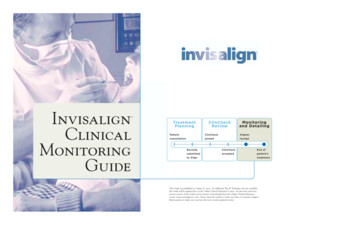
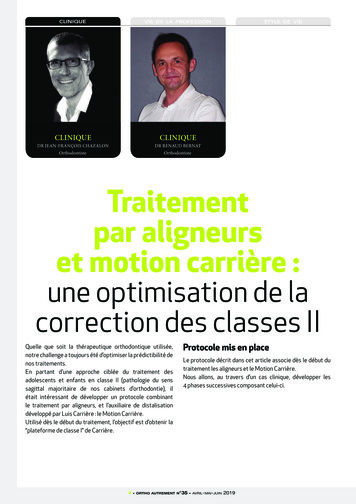
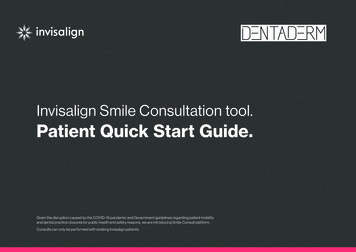
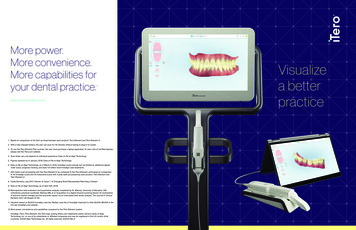
![Welcome [neso ]](/img/18/neso-2019-onsite-program.jpg)
